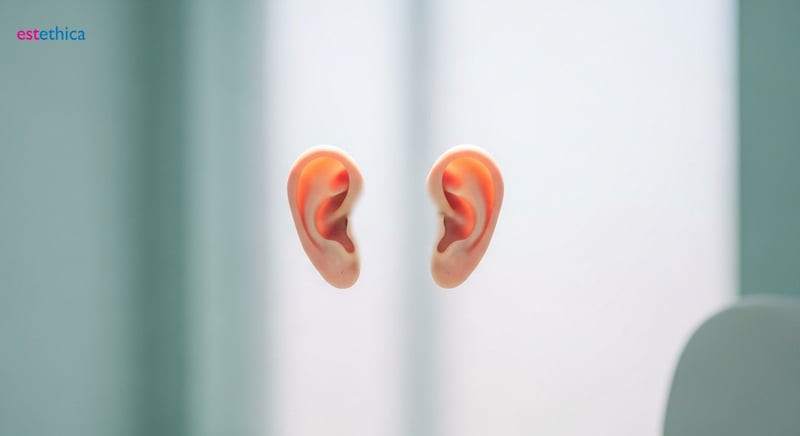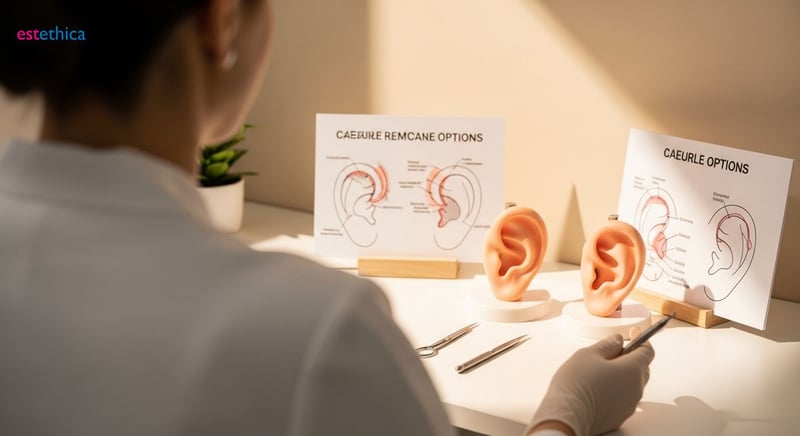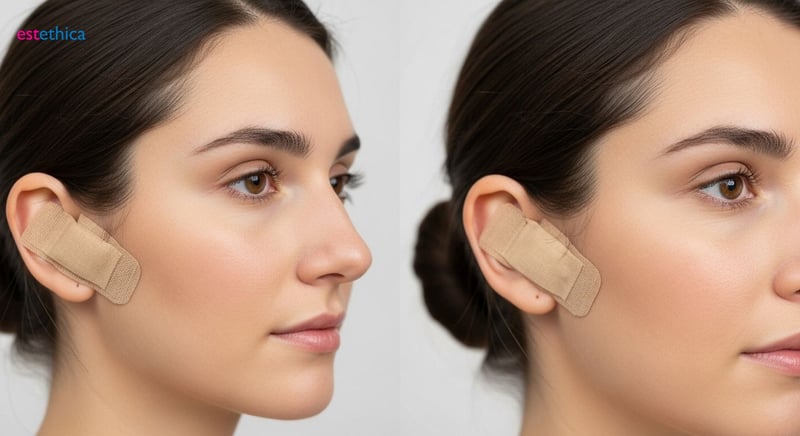Redefine Your Profile: The Art of Ear Reshaping
Transform your profile with ear reshaping. Discover otoplasty and its benefits today!
Discover the transformative potential of ear surgery with our comprehensive guide on otoplasty. This cosmetic procedure can harmonize your facial aesthetics by reshaping the outer ear structure, addressing both cosmetic and functional concerns. Whether seeking ear pinning or correction of malformed ears, the right approach tailors to your needs.
Cosmetic Ear Surgery: Crafting Harmony & Balance
Understanding the Nuances of Cosmetic Ear Surgery
Cosmetic ear surgery, or Ear Reshaping, goes beyond mere aesthetics; it's about enhancing an individual's overall facial harmony. The procedure, often sought to address protruding ears, involves meticulous sculpting and repositioning of cartilage. This precision aims to achieve a natural and balanced look, boosting self-confidence. Consider, for instance, how a subtle adjustment can transform the appearance and self-perception, especially for those who have felt self-conscious about their ear shape since childhood. Otoplasty is tailored to meet the unique needs and desired outcomes of each patient.
Factors Influencing the Suitability of Ear Reshaping Surgery
- Ear Prominence: Individuals with ears that protrude noticeably from the head often seek otoplasty to bring them closer, enhancing facial balance.
- Congenital Anomalies: Otoplasty addresses structural differences, such as Stahl’s ear or constricted ear, promoting both aesthetic improvement and functional normality.
- Asymmetrical Concerns: Pinnaplasty can remarkably correct size or shape differences between the ears, achieving a balanced and symmetrical appearance.
Beyond these factors, the overall health and psychological readiness of the individual play essential roles in determining the suitability and expected outcome of the surgery. Otoplasty is designed to provide proportionate appearance.
The Process and Considerations for Otoplasty Candidates
The decision to undergo ear surgery involves several important considerations. Firstly, individuals should have realistic expectations about the results, understanding that the surgery aims for improvement rather than perfection. Secondly, the elasticity of the patient’s ear cartilage is a crucial factor, particularly in adults, as it affects the ease of reshaping During the procedure, meticulous incisions are made to expose the cartilage, which is then reshaped and secured with sutures to achieve the desired form. Cosmetic ear surgery can address aesthetics.
Steps Involved in Pinnaplasty
- Initial Consultation: A comprehensive assessment of ear structure and discussion of aesthetic goals to tailor the surgical plan.
- Cartilage Reshaping: Precise modification of the ear cartilage to correct deformities, reduce protrusion, or adjust size.
- Suturing and Closure: Securing the new ear shape with sutures and closing the incisions, often with techniques minimizing visible scarring.
Following the procedure, a period of healing is necessary, often accompanied by swelling and bruising, which typically subsides within a few weeks.

Otoplasty Recovery: What to Expect After Ear Pinning
Navigating the Initial Phase After Ear Surgery
The initial days post-otoplasty are characterized by swelling and discomfort, which are natural responses to the surgical intervention. Pain management is a crucial aspect of this phase, typically addressed with prescribed analgesics. Adherence to the surgeon's medication schedule is imperative for maintaining comfort. Patients often find that applying cold compresses helps reduce swelling and alleviate pain. Moreover, keeping the head elevated during rest and sleep can significantly minimize edema. The use of prescribed antibiotics is also common. Ensuring diligent wound care as instructed prevents infection and promotes optimal healing. Proper hydration and nutrition are vital for supporting the body’s recovery processes after Otoplasty. Rest and relaxation are key for a smooth recovery.
Guidelines for a Smooth Otoplasty Recovery
- Medication Management: Following the prescribed medication regimen is critical for both pain relief and preventing potential infections during the initial recovery phase.
- Proper Head Positioning: Keeping the head elevated, especially during sleep, helps reduce swelling and promotes better circulation to the surgical area.
- Gentle Wound Care: Adhering to the surgeon's instructions on cleaning and dressing the incision sites is essential to minimize the risk of infection and ensure optimal healing.
By following these guidelines, patients can enhance their comfort and facilitate a quicker and more effective healing process after ear pinning. Consistent adherence to these practices supports the body's natural recovery mechanisms. Paying close attention to these details is essential for achieving the best possible outcome from the ear surgery.
Long-Term Expectations Following Cosmetic Ear Surgery
As the initial recovery phase subsides, patients can gradually resume their normal routines, typically within one to two weeks. However, it’s essential to avoid strenuous activities and contact sports for several weeks to prevent any trauma to the healing ears. Scars from the otoplasty incisions will fade over time, becoming less noticeable. Regular follow-up appointments with the surgeon are crucial for monitoring the healing progress and addressing any concerns. The final results of the surgery become more apparent as the swelling completely diminishes, revealing the improved ear contour. Maintaining a healthy lifestyle supports long-term healing and preserves the aesthetic outcome. Over the months following otoplasty, the ears settle into their new position, and patients often experience a significant boost in self-esteem. Cosmetic Ear Surgery helps promote well-being.
Key Milestones in Otoplasty Recovery
- Resumption of Light Activities: Return to non-strenuous daily routines within one to two weeks, ensuring minimal physical strain on the ears.
- Scar Fading: Gradual reduction in the visibility of surgical scars over several months, with continued improvement in appearance.
- Final Outcome Assessment: Full appreciation of the surgical results as swelling resolves, typically revealing the refined ear shape and improved facial harmony.
The journey to complete recovery involves patience and adherence to post-operative care instructions, culminating in enhanced aesthetic satisfaction and improved quality of life after the otoplasty surgery.

Malformed Ear Correction: Advanced Techniques for Reconstruction
Innovative Approaches to Correcting Ear Deformities
Advanced techniques in malformed ear correction involve reconstructive procedures designed to repair ear deformities resulting from injuries or congenital conditions. These sophisticated methods aim not only to restore the ear's appearance but also to enhance its functionality, offering patients a chance to regain both form and function. For instance, a child born with microtia, a condition where the ear is underdeveloped, might undergo a series of reconstructive surgeries to create a fully formed ear. Similarly, adults who have lost part of their ear due to trauma can benefit from these advanced techniques, which utilize cutting-edge surgical precision.
Understanding Surgical Frameworks in complex Ear Surgeries
- Autologous Reconstruction: Using the patient's own rib cartilage to create a natural and compatible framework for the new ear structure.
- Synthetic Implants: Employing biocompatible materials to construct the ear framework, providing an alternative when autologous material is not feasible.
- Microvascular techniques: Involving the transfer of tissue with its blood supply to reconstruct complex defects, offering a robust and lasting solution.
Furthermore, these procedures frequently require a multidisciplinary approach involving plastic surgeons, ENT specialists, and sometimes even pediatric surgeons, ensuring comprehensive care and optimal outcomes. These carefully orchestrated surgeries aim to deliver aesthetically pleasing results while maintaining the ear's natural look, thus improving the patient’s overall quality of life. Cosmetic Ear Surgery at estethica global can help.
The Art and Science Behind Reconstructive Ear Surgery
The procedures typically involve crafting a framework, either by utilizing the patient’s own rib cartilage or through the use of synthetic materials, each tailored to meet the individual requirements of the patient. Autologous reconstruction, using the patient's own tissues, minimizes the risk of rejection and provides a natural feel and appearance. The use of synthetic materials, such as porous polyethylene, offers a viable alternative when autologous options are limited. For example, If a patient has insufficient rib cartilage due to previous surgeries, a synthetic framework might be the preferred choice. The ultimate goal is to ensure that the reconstructed ear blends harmoniously with the patient's overall facial features, enhancing their self-confidence and well-being. Every year, numerous individuals seek Ear Reshaping.
Technological Innovations in Ear Reconstruction
- 3D Modeling: Utilizing three-dimensional printing technology to create precise models of the ear, guiding the surgical process and ensuring accurate reconstruction.
- Computer-Assisted Design: Employing CAD software to design and customize ear implants, allowing for a perfect fit and natural appearance.
- Microsurgical Techniques: Using high-powered microscopes to perform delicate procedures, enhancing precision and minimizing scarring.
The expertise of the surgeon is key to achieving optimal aesthetic results. Otoplasty surgery requires an artistic eye, and a thorough understanding of facial anatomy. estethica global surgeons can contribute to the success of the malformed ear correction.

Adult vs. Teen Otoplasty: Tailoring the Approach
Distinct Motivations Behind Seeking Cosmetic Ear Surgery
The motivations driving adults and teens to undergo cosmetic ear surgery often differ significantly. Adults might choose otoplasty to correct issues from previous surgeries or due to ongoing dissatisfaction with their ear appearance. For example, an adult who had ear surgery in childhood might seek a revision to refine the results. Teens, on the other hand, frequently pursue otoplasty to avoid bullying or social discomfort related to prominent ears. Understandably, this age group is particularly sensitive to peer perception and the potential psychological impact of physical appearance. Irrespective of age, otoplasty offers an opportunity to improve confidence.
Key Considerations for Surgical Approaches and Techniques
- Age-Specific Cartilage Properties: Surgical planning must account for the differing flexibility and structure of cartilage between younger and older individuals.
- Individual Aesthetic Goals: Understanding the patient's specific desires—whether subtle refinements or more pronounced changes—is critical for achieving satisfaction.
- Overall Ear Structure: Surgeons tailor the surgical technique based on individual ear anatomy.
Each patient’s ear structure is unique, requiring a personalized surgical plan to achieve the best possible aesthetic outcome. Approximately 3% of the population has prominent ears, making otoplasty surgery a fairly common procedure.
Customizing Otoplasty: Tailoring Techniques to Patient Needs
Successful otoplasty hinges on customizing the surgical technique to match the patient's age, ear structure, and specific aesthetic goals. For instance, a teen seeking to reduce the protrusion of their ears might benefit from cartilage-sparing techniques to preserve ear flexibility. Alternatively, an adult addressing previous surgical outcomes may require more extensive remodeling. Surgeons consider these factors to deliver personalized results. This tailored approach ensures that the outcomes align with the patient's expectations, fostering satisfaction with the results. A consultation with an estethica global surgeon help determine the best course of action.Ear Reshaping is performed at estethica global.
Elements of Personalized Otoplasty Plans
- Comprehensive Evaluation: Detailed assessment of ear anatomy and patient’s aesthetic desires to formulate a tailored surgical approach.
- Technique Adaptation: Customizing surgical methods based on age, cartilage properties, and the extent of correction needed.
- Realistic Goal Setting: Establishing achievable expectations to ensure patient satisfaction with the final aesthetic outcome.
Focusing on these elements, estethica Global ensures that each patient receives a customizedOtoplasty plan.
Understanding Otoplasty: A Comprehensive Guide
Innovative Cartilage Reshaping & Reconstruction Techniques for Improved Ear Aesthetics & Function
Patient-Centric Otoplasty: Ensuring Comprehensive Care & Optimal Recovery
Frequently Asked Questions
What is Cosmetic Ear Surgery (Otoplasty) and what does it address?
What should I expect during the recovery period after Ear Pinning?
What advanced techniques are used in Malformed Ear Correction?
How does Otoplasty differ between adults and teens?
What is the overall goal of Ear Reshaping procedures?
Achieve your aesthetic goals with world-class expertise and personalized care.
📞 Get Your Free Consultation!